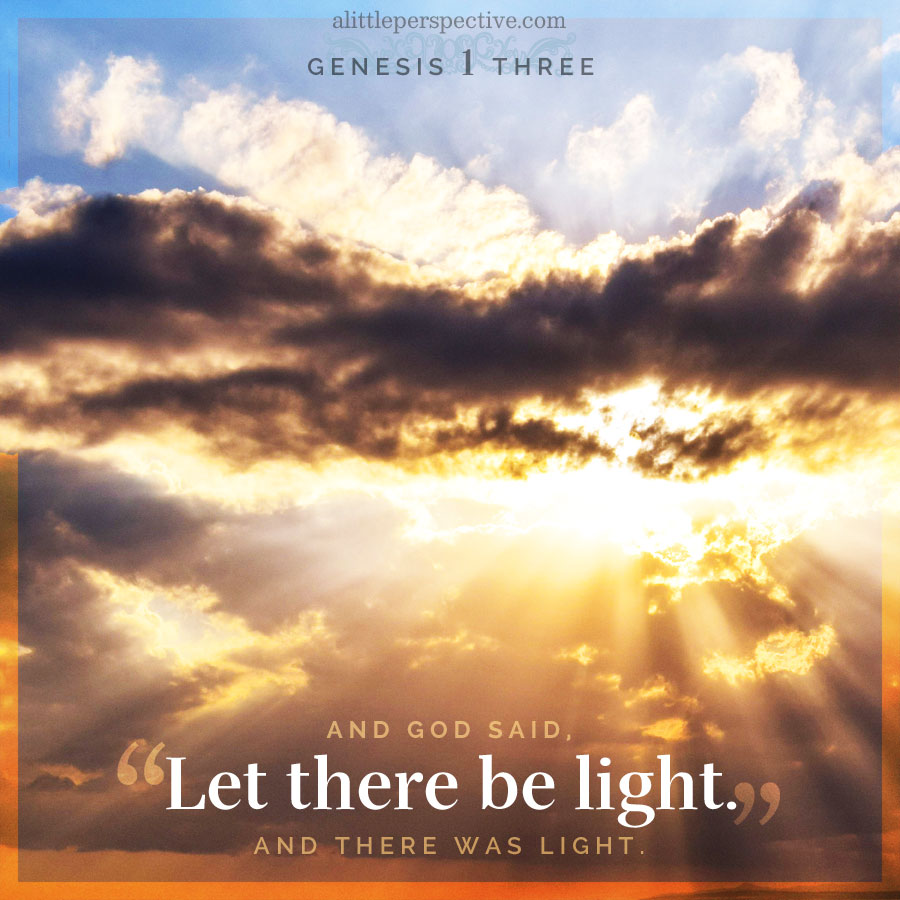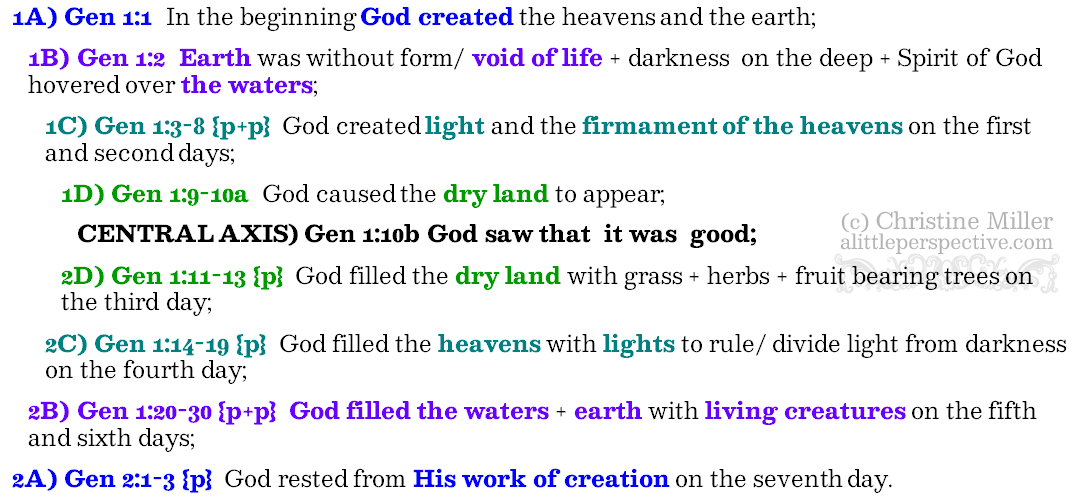Read Genesis 1:1-2:3 at Bible Gateway.
God has embedded several teaching tools in Torah and throughout Scripture to help communicate His message. He wants to be understood, but He does not throw His pearls before swine (Mat 7:6). His gold and silver requires deeper digging, but treasure can be unearthed for those willing to look for it (Pro 2:1-6)! As it turns out, all of Scripture’s teaching tools are introduced in the first chapter of Genesis, so that once learned, they can then be used to study the rest of Scripture. They are:
Plain meaning of the text. God’s Word means what it appears to mean, upon the simple reading of the text.
In the beginning God created the heavens and the earth. Gen 1:1
Our universe is a product of special design by an intelligent Creator, and not a product of random chance.
Then God saw everything that He had made, and indeed it was very good. So the evening and the morning were the sixth day. Gen 1:31
Since evening and morning occur in every 24-hour cycle of time, God completed His creation in six 24-hour days, and not six eons of time.
Patterns and repetition. The Scripture often establishes patterns in the narrative. The repetition draws our attention to the fact that it cannot be coincidence; therefore Scripture is trying to make a point about something.
In Gen 1, each day begins with the same phrase, “Then God said,” day after day, exactly the same. So we see that God brought into being that which did not exist by His Word.
In the beginning was the Word, and the Word was with God, and the Word was God. He was in the beginning with God. All things were made through Him, and without Him nothing was made that was made. Joh 1:1-3
Sometimes the pattern previously established is broken, to draw attention to the break.
Beginning in Gen 1:12, a pattern is revealed once God begins filling His creation with life. Everything living was made according to its kind. Grass, herbs, fruit bearing trees, sea creatures … all the way to the beasts of the field (Gen 1:12, 21, 24-25). But then when God creates man, He seems to break the pattern, for nothing is said of “according to its kind” for the first time, even though everything is “according to its kind” up until this point (Gen 1:26-28). But then:
Then God said, “Let Us make man in Our image, according to Our likeness;” Gen 1:26.
Man is made also according to his kind, which is in God’s own image, in His “kind!” Man is an eternal spiritual being, created to be the seed or children of God from the beginning! Oh my goodness …
Hebrew paragraph divisions. God’s paragraph divisions, when He has concluded one topic and is ready to go on to the next, are present in the original Hebrew of the Scripture. There are two kinds – a weak division and a strong division. A weak division (which I mark with {s} since the Hebrew word for it begins with the ‘s’ sound) indicates another facet of the same theme. A strong division (which I mark with {p} since the Hebrew word for it begins with the ‘p’ sound) indicates a new theme.
These paragraph divisions have been preserved by the Hebrew scribes who faithfully copied every letter of Scripture without variation. They were discarded by the English translators (because admittedly, they sometimes do not make sense to human logic). But God has divided His paragraphs the way He has for a reason: He is trying to teach us something! Where the paragraph divisions aren’t are often just as telling as where they are.
Gen 1:1-2:3 Hebrew paragraph divisions
Gen 1:1-5 {p} First day of Creation: space, time, matter, energy (light)
Gen 1:6-8 {p} Second day of Creation: firmament of the heavens
Gen 1:9-13 {p} Third day of Creation: dry land, plant life
Gen 1:14-19 {p} Fourth day of Creation: lights in the firmament of the heavens
Gen 1:20-23 {p} Fifth day of Creation: birds, sea life
Gen 1:24-31 {p} Sixth day of Creation: animal life on land, man
Gen 2:1-3 {p} Seventh day of Creation: rest
The divisions make it apparent that the days of creation are significant. There are Hebrew words for other lengths of time, such as years or eons, if those units of time were meant. But God chose the Hebrew yom – “day” – the regular 24-hour day. It sometimes comes as a shock to realize that a day as a unit of time, is one of the few that do not depend on the sun, moon, or stars for marking it. The 24-hour day is the time it takes for the earth to revolve on its axis one revolution; no sun or moon is needed.
Strong themes. The Scripture not only divides itself into its paragraphs by its markers, but it also divides itself into what I call strong themes. Recall that a strong paragraph marker {p} indicates the completion of a theme or topic, while an weak marker {s} indicates another facet of the same theme.
The very next paragraph in Genesis following the Creation account in Gen 1:1-2:3, is from Gen 2:4-3:15 and is ended with a weak marker {s}. There are more weak paragraphs following, and the next strong marker occurs at the end of Gen 3:21.
shweak facet shi +hweak facet h+ concluding facet ii= shistrong theme
Gen 2:4-3:15 {s} + Gen 3:16 {s} + iGen 3:17-21 {p} si= Gen 2:4-3:21 {s+s+p}
Now if Gen 2:4 begins a new strong theme which is concluded in Gen 3:21, Gen 2:3 concludes its own strong theme teaching a single overarching topic:
Gen 1:1-2:3 {px7 (seven concurrent strong facets)} God is our Creator
Gen 2:4-3:21 {s+s+p} Disobedience to God is sin, and carries the consequence of painful toil and death
Chiastic structure. A chiastic structure is a narrative with a central point that is the key point of the passage, and the Scripture points to that point as the narrative around it zeros in on it like an arrow. This is how: Let’s say there are four elements or ideas in a passage that lead up to the central point. Following the central point, the same elements or ideas will be repeated in some way, but in reverse order. There can be any number of elements or ideas. But that they repeat in reverse order around a central point is the key characteristic.
Gen 1:1-2:3 {px7} chiastic structure
Notice that the paragraph divisions help define the elements of the structure. You can see that besides the central point – that God’s creation was good, not one full of predation and death – the repeating elements then make matching pairs, which bring even more clarity to the text. In this case, the structure reveals that God first formed the universe, which was void, saw that its form was good, then filled the universe that He had prepared with life.
Original Hebrew. The Old Testament Scriptures were penned (for the most part) in ancient Hebrew, God’s beautiful language. Investigation into the Hebrew root words in a passage reveals so much that out of necessity translation misses!
In the beginning, God created the heaven and the earth. Gen 1:1
The Hebrew for “God” is Elohiym “the true God,” Strong’s H430, itself the plural of Strong’s H433, elowahh, “any god, a false god,” the emphatic of Strong’s H410, el, “god, god like, mighty one, hero.” El is the shortened form of Strong’s H352, ayil, “ram, capitals (of columns), noble, strong tree,” which is itself derived from the three-letter root, Strong’s H193, uwl, “to roll, strength, power, preeminence, leader, belly, abdomen.”
In order to arrive at a word which can even come close to adequately describing the Being whose preeminence, greatness, might, and glory is indescribable, the word for strength, preeminence, nobility, and leadership first has to be made emphatic, then that result had to be magnified (made plural or multiplied).
The three- letter root of Elohiym is aleph + vav + lamed, in the ancient Hebrew pictographs the ox head (strength, power, leader) + the nail or tent peg (add, secure, hook) + the shepherd’s staff (teach, yoke, to, bind). The story told by this three- letter root is of the Shepherd added to the Sovereign! Right away in the very first verse of Genesis, God reveals of Himself that yes, He is awesome in His creative wisdom and great might and power – but it is not arbitrary might or tyrannical power; it is intrinsically secured to the heart of the Good Shepherd!
genesis 1:1-2:3 and the teaching tools of scripture, part two
For further study on site
the teaching tools of scripture
Genesis index of studies
For further study off site
Restoration of Torah Parashat haShavuah Study Series (teaching tools)
Hebrew Bible in English (paragraph divisions)
The Ancient Hebrew Research Center (original Hebrew)


















Oh my goodness … have had these questions since following you …. thank you … however …. have to read repeatedly this teaching and meditate to truly see and enlarge my capacity to receive … and apply to all scripture ….hugs dear heart
Hugs Kathy, be blessed in your studying today! <3